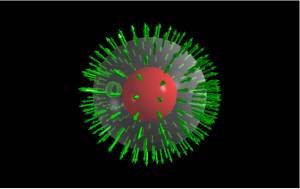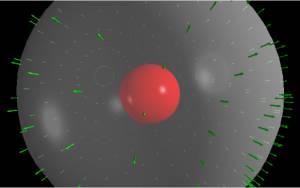Motivation for Gauss's Law
Last week, we learned about Ampere's Law, which was a cool shortcut for finding magnetic fields in highly symmetric situations. This week we will talk about a similar short for finding electric fields in symmetric situations, called Gauss's Law. While Gauss's Law has many similar features to Ampere's Law, there are a couple of key differences. First, we will be talking about enclosing a charge, rather than a current (since we are returning to a discussion about electric fields). Second, rather than talking about the magnetic field around an imagined loop, we will be talking about the electric field around an imagined area. The notes this week will step through each of the pieces of Gauss's Law, starting with introducing the general concept of Gauss's law before we talk about the mathematics and the advantages and disadvantages to using it.
Conceptualizing Gauss's Law around a Point Charge
Back at the beginning of the semester, we talked about how to find the electric field from point charges, lines of charge, and distributions of charge (i.e., cylinders, spheres, or planes of charge). The method of building a field from a point charge can also be used for a 2D sheet of charge or a 3D volume of charge and will always work; however, the mathematical calculation needed to determine the field can become much more complicated (you have to use either a double or triple integral). In some of these cases, Gauss's Law works as a shortcut for finding the electric field from complicated charge distributions. However, there are trade offs for using this shortcut – it is always true, but only useful in highly symmetric situations. In the end, both of these methods are built around the same idea, even though the mathematics we will use is different: charges create electric fields.
First, let's go back to our example of the point charge. The electric field points away from a positive charge. If we imagine a spherical bubble (like a very thin shell) around the point charge, we could think about the strength of the electric field that is on the surface of our imagined bubble (shown in the figure to the right).
Now if we imagine our bubble (typically called the “Gaussian surface”) to be a little bit bigger than it was before, two things happen:
- The strength of the electric field decreases. The decrease is proportional to $1/r^2$ because $\vec{E} = \frac{1}{4\pi\epsilon_0}\frac{q}{r^2}\hat{r}$ for a point charge.
- The area of the imagined bubble or imagined Gaussian surface increases. The increase in area is proportional to $r^2$ because the surface area of a sphere is $A=4\pi r^2$.
This suggests that the electric field at the surface of the imaginary sphere multiplied by the surface area of the imaginary sphere is a constant; this product is called electric flux.
If we are considering a closed surface, like a bubble that encapsulates a charge, we are dealing with the total electric flux. If you draw the Gaussian surface with a larger radius, the electric field will be smaller, but the total electric flux is constant. If you draw the Gaussian surface with a smaller radius, the electric field will be greater, but the total electric flux is constant.
Gauss's Law is built around this idea that the total electric flux is constant through the imagined bubble (no matter where we draw the surface of the bubble) and that electric flux is related to the amount of charge inside the bubble (the point charge in this case). It turns out this relationship is always true - for any shape of charge (line, sphere, blob, etc.) and for any closed Gaussian surface, the electric flux on that surface is directly related to the charge inside the surface. Mathematically, we will write this idea behind Gauss's law as: $$\Phi_{tot}=\int \vec{E} \bullet \vec{dA}=\frac{Q_{enclosed}}{\epsilon_0}$$ Where $\Phi_{tot}$ is the total electric flux through the Gaussian surface (which is calculated from the electric field $\vec{E}$ along the surface area of the Gaussian surface $d\vec{A}$) and $Q_{enclosed}$ is the amount of charge enclosed by the Gaussian surface. $\epsilon_0$ is the same constant that we used in the beginning of class: $8.85*10^{-12}\frac{C^2}{Nm^2}$.
Note that the Gaussian surface is completely imaginary, just like the Amperian Loop - we are not physically placing some surface around the charge. As we will talk about later, the choice of where to draw the surface and what shape to draw it is up to you; however, certain choices will lead to math that is virtually impossible, so we will want to be careful in our choice of surface. We will spend the next few pages of notes talking about each of the pieces of Gauss's Law, but this is the general conceptual idea behind the math.

